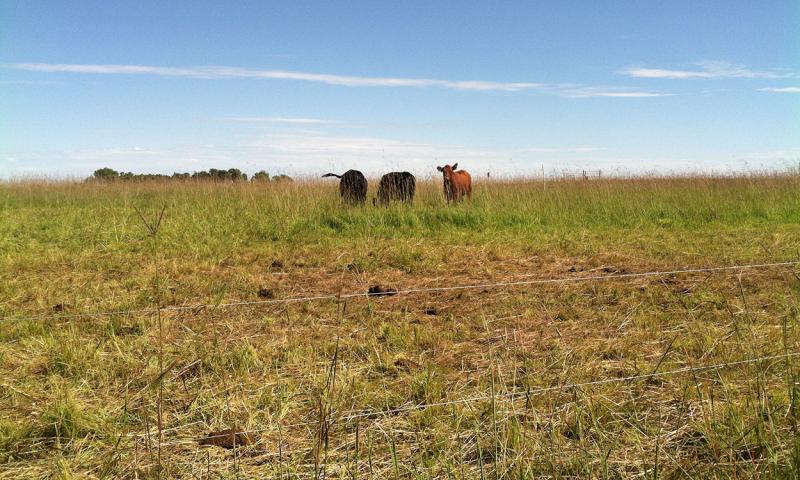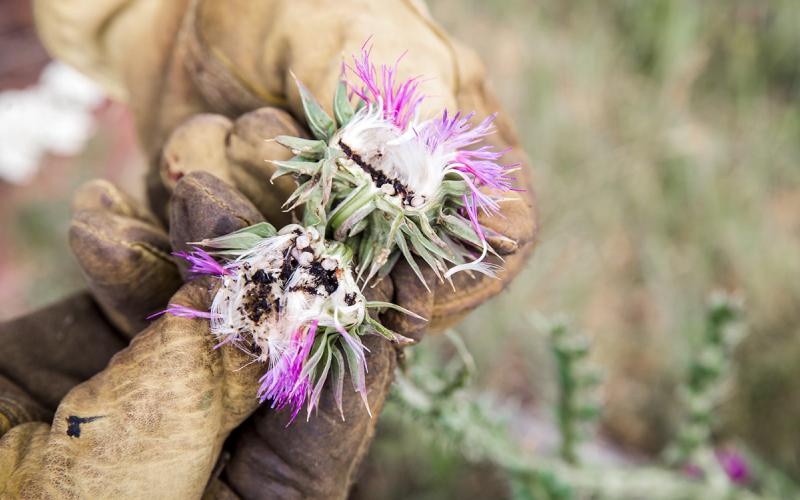Written collaboratively by Pete Bauman, Karla Hernandez and Sandy Smart.
Part three and part four of this series highlighted nitrogen (N) fertilization impacts on native grassland communities. This article addresses N effects on planted native grasses in various situations.
Nitrogen fertilization of planted grasslands can have substantial impacts to overall plant community production. However, the overall impact of N application to the plant community is largely dependent on the composition of the grass field. Further, management goals and objectives of the planted grassland are an important driver in the consideration of whether artificial N applications will be beneficial or harmful. Here we will discuss various plant communities and the implications of fertilization on each.
Fertilizer Impacts on Various Plant Communities

High-diversity native grass plantings.
There are several planted grass communities and a variety of management objectives associated with each. The first general category is high-diversity, planted grasslands that are often established and managed by conservation organizations or agencies and are often planted for the overall benefit of the ecosystem. These high-diversity plantings often lie in close proximity to existing diverse, native prairie and are managed as a complimentary habitat component. These plantings may consist of dozens of native grasses and forbs established at a considerable cost and thus are often managed with tools and techniques tailored specifically for the propagation of the native species and against non-native invasive grasses and broadleaf plants. Common tools may consist of fire, herbicides, grazing, clipping or haying (Figure 1). Recently, several agency-managed private land programs have promoted high-diversity native plantings, as the benefits to pollinator species, such as bees and butterflies, have been realized.
Nitrogen applications to high-diversity grass plantings.
In healthy native grass plantings with only limited invasion of non-native grasses, nitrogen fertilization will likely bolster the competitive advantage of the undesirable invasive grasses. This in turn will have a negative impact on the plant community, likely leading to reductions and possibly elimination of native plants from the system over time. Native plantings are often dominated by large and robust native grasses that can impact forb establishment through competition for light and litter accumulation. Adding N to this system will likely only increase overall biomass production through stimulation of the non-native grasses, thus further reducing the ability of the planted forbs to establish. In addition, once the invasive species gain a competitive advantage, they will likely continue to self-propagate and gain dominance in the community, leading to additional reductions in native plant diversity and richness.
Low-diversity native grass plantings.
Grasslands enrolled in the Conservation Reserve Program (CRP) are a good example of low-diversity native grass plantings. These fields are often planted to fairly robust commercial cultivars of a handful of native grass species, such as big bluestem, switch grass, Indian grass, little bluestem, side oats grama and other common warm-season species. In most cases, these grasses are complimented with a variety of native flowering broadleaf forbs. Due to program regulations, management or disturbance, actions in these grass fields often only occur on a three-to-five year basis after initial establishment, which can lead to the accumulation of heavy litter or thatch. While this litter can at times be beneficial for wildlife needs, such as nesting, it can be limiting to the movement of young chicks or to the recruitment of seedlings.
Nitrogen applications to low-diversity native grass plantings.
In many cases, site preparation of these fields fails to completely eliminate invasive non-native grasses or broadleaf weed seeds from the soil, thus invasion of these species is often prevalent fairly early during the establishment of these grass plantings and can persist throughout the life of the planting. Nitrogen additions to these fields can propagate undesirable species, such as smooth bromegrass and Canada thistle, likely increasing shading and competition for light and adding to the annual accumulation of litter and reduced recruitment of desirable plants.
Case Study Four: Florence Area, Codington County
2013 Nitrogen effects on production of CRP fields planted to native warm-season grasses.
In this study, the landowner had historic CRP fields that were planted primarily to big bluestem and Indiangrass. The fields were enrolled into a permanent grassland conservation easement, and it was the intention of the landowner to maintain the grass in a high-quality native stand. The landowner leased the fields to a neighboring producer, who harvested an annual hay crop. The renter was interested in maximizing hay production and proposed N fertilization as a means of improving yield.
Three fields were included in this small study. Approximately one-acre plots in each of the three fields were fertilized with 97 pounds/acre N applied on May 2, 2013. Bulk N (46-0-0) was applied at an actual rate of 210.8 pounds/acre and a cost of $545/ton. After application fees, N application costs were $63.20/acre.
South Dakota State University (SDSU) Extension field staff was invited to conduct yield and soils assessments at the site, and samples were collected on August 7, 2013 at near peak production of the native grasses. Clipping was conducted utilizing standardized methods with a 0.96 ft2 clipping ring, dried in a drying oven at SDSU and weighed on a digital gram scale. Average production of the N-fertilized plots (n=3) was 6,150 pounds/acre and was significantly higher than the unfertilized plots (n=6) which averaged 2,838 pounds/acre (p=0.01). The average difference in yield between fertilized and unfertilized was 3,312 pounds/acre.
Three soil core sub-samples were collected along with the vegetation samples from each of the sample areas listed above utilizing a 12” soil probe. Soil samples were analyzed for N and carbon content at the SDSU soil lab. Soil carbon averaged 42.7% in the fertilized plots. While not significantly higher than the 41.5% soil carbon level in the unfertilized plots, statistical analysis indicated a possible trend in higher soil carbon in the fertilized plots that might have been realized if more samples had been collected (p=0.07). Soil N content was 0.86% in the fertilized plots and was not significantly different than the 0.82% soil N recorded in the unfertilized plots (p=0.32).
Interpretation
Nitrogen-fertilized plots outperformed the unfertilized plots. The bulk of the biomass produced in the fertilized plots was heavily dominated by smooth bromegrass in contrast to planted native grasses, which dominated the unfertilized areas. Fertilization improved yield by an average of 3,312 pounds/acre at a cost of $63.20/acre, for an average cost of $38.16/ton of additional biomass produced. At an average of roughly $100–$120/ton price (August 2013) for CRP grass sales, the profit margin of fertilization of this grass hay may have been approximately $60–$80/ton or $165–$199/acre (Source: Dakota Hay Auction).
The year 2013 was excellent for smooth bromegrass growth in northeast South Dakota. Fertilized plot samples were comprised primarily of smooth bromegrass, causing the landowner to be very concerned about the short and long-term effects of N application on the integrity of the native grass stand. There was a wide distribution of smooth bromegrass throughout the stand, but nowhere was it as prevalent as it was in the one-acre fertilized plots, where it was robust, visible and dominated the plant community. Continued fertilization in these fields would likely have increased smooth brome production, increasing competition with native grasses and decreasing the viability of warm-season native grasses.
|
Planted CRP |
Unfertilized |
Total Soil N (%) |
Total Soil C (%) |
Lbs./Acre |
Lbs./Acre by Treatment |
Community Composition |
|---|---|---|---|---|---|---|
| CRP |
|
|
|
|
|
Dominated by smooth brome with some native warm-season grasses present. |
| CRP |
|
|
|
|
||
| CRP |
|
|
|
|
||
| CRP |
|
|
|
|
|
Dominated by native warm-season grasses with some smooth brome present. |
| CRP |
|
|
|
|
||
| CRP |
|
|
|
|
||
| CRP |
|
|
|
|
||
| CRP |
|
|
|
|
||
| CRP |
|
|
|
|
Reference: Bauman and Hernandez
Resources and References:
- Nutrient Network: Includes links to several articles on the topic.
- Alpert, P., E. Bone, and C. Holzapfel. 2000. Invasiveness, invisibility and the role of environmental stress in the spread of non-native plants. Perspectives in plant ecology, evolution, and systematics. 3:52-66.
- Borer, E.T., E.W. Seabloom, D.S. Gruner, W.S. Harpole, H. Hillebrand4, E.M. Lind1, P.B. Adler, J. Alberti, T.M. Anderson, J.D. Bakker, L. Biederman, D. Blumenthal, C.S. Brown, L.A. Brudvig, Y.M. Buckley, M. Cadotte, C. Chu, E.E. Cleland. M.J. Crawley, P. Daleo, E.I. Damschen, K.F. Davies, N.M. DeCrappeo, G. Du, J. Firn, Y. Hautier, R.W. Heckman, A. Hector, J. HilleRisLambers, O. Iribarne, J.A. Klein, J.M. H. Knops., K.J. La Pierre, A.D.B. Leakey, W. Li, A.S. MacDougall, R.L. McCulley, B.A. Melbourne, C.E. Mitchell, J.L. Moore, B. Mortensen, L.R. O’Halloran, J.L. Orrock, J. Pascual, S.M. Prober, D.A. Pyke, A.C. Risch, M. Schuetz, M.D. Smith, C.J. Stevens, L.L. Sullivan, R.J.Williams, P.D. Wragg, J.P. Wright, and L.H. Yang. 2014. Herbivores and nutrients control grassland plant diversity via light limitation. Nature. 00:1-4.
- Dickson, T.L. and B.L. Foster. 2011. Fertilization decreases plant biodiversity even when light is not limiting. Ecology Letters. 14:380-388.
- Foster, B.L., and K.L. Gross. 1998. Species richness in a successional grassland: effects of nitrogen enrichment and plant litter. Ecology. 79:2593-2602.
- Gerwing, J., A. Bly, L. Butler, D. Curtis, and G. Erickson. 2004. Fertilizer N and P influence on pasture yield in McPherson County SD in 2004 (projects 35004 and 35104). Soil/water research. South Dakota State University. 2004 progress report. Agriculture Experiment Station. Plant Science Department. Soil PR 04-7:1-3.
- Harpole, W.S., and D. Tilman. 2007. Grassland species loss resulting from reduced niche dimension. Nature. 446:791-793.
- Hautier, Y., P.A. Niklaus, and A. Hector. Competition for light causes plant biodiversity loss after eutrophication. 2009. Science. 324:636-638.
- Hautier, Y., E.W. Seabloom, E.T. Borer, P.B. Adler, W.S. Harpole, H. Hillebrand, E.M. Lind, A.S. MacDougall, C.J. Stevens, J.D. Bakker, Y.M. Buckley, C. Chu, S.L. Collins, P. Daleo, E.I. Damschen, K.F. Davies, P.A. Fay, J. Firn, D.S. Gruner, V.L. Jin, J.A. Klein, J.M.N. Knops, K.J. La Pierre, W. Li, R.L. McCulley, B.A. Melbourne, J.L. Moore, L.R. O’Halloran, S.M. Prober, A.C. Risch, M. Sankaran, M. Schuetz, and A. Hector. 2014. Eutrophication weakens stabilizing effects of diversity in natural grasslands. Nature. 508:521-525.
- Hector, A., Y. Hautier, P. Saner, L. Wacker, R. Bagchi, J. Joshi, M. Scherer-Lorenzen, E. M. Spehn, E. Bazeley-White, M. Weilenmann, M. C. Caldeira, P. G. Dimitrakopoulos, J. A. Finn, K. Huss-Danell, A. Jumpponen, C. P. H. Mulder, C. Palmborg, J. S. Pereira, A. S. D. Siamantziouras, A. C. Terry, A. Y. Troumbis, B. Schmid, and M. Loreau. 2010. General stabilizing effects of plant diversity on grassland productivity through population asynchrony and overyielding. Ecology. 91:2213-2220.
- Lamb, E.G. 2008. Direct and indirect control of grassland community structure by litter, resources, and biomass. Ecology. 89:216-225.
- Seabloom, E. W., C.D. Benfield, E.T. Borer, A.G. Stanley, T.N. Kaye, P.W. Dunwiddie. 2011. Provenance, life span, and phylogeny do not affect grass species' responses to nitrogen and phosphorus. Ecological Applications. 21:2129-2142.
- Silvertown, J.P, P. Poulton, E. Johnston, G. Edwards, M. Heard, and P.M. Bliss. 2006. The Park Grass Experiment 1856-2006: Its contribution to ecology. Journal of Ecology. 94:801-814.
- Stevens, C.J., N.B. Dise, J.O. Mountford, and D.J. Gowing. 2004. Impact of nitrogen deposition on the species richness of grasslands. Science. 303:1876-1879.


